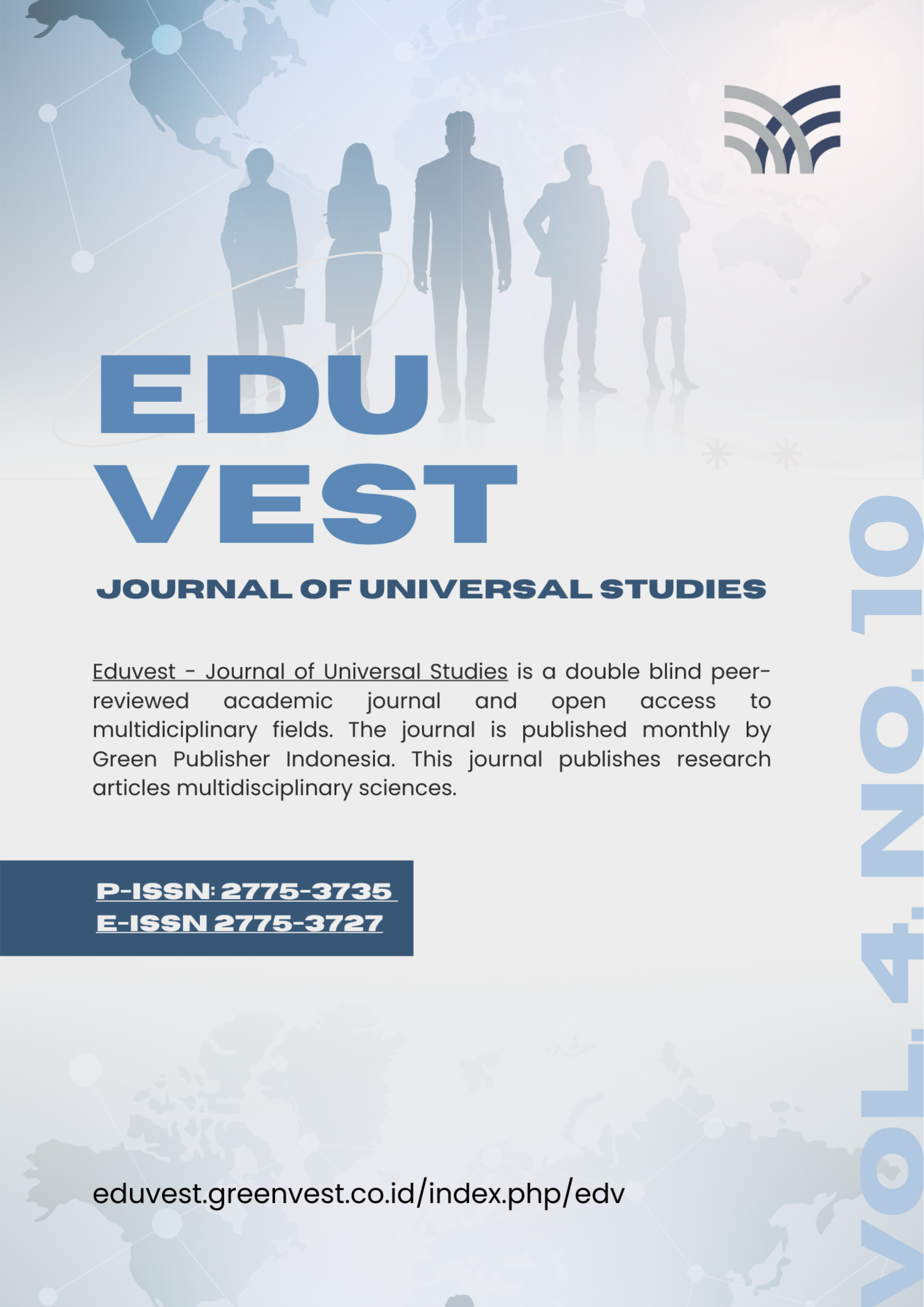Unveiling Gender Dynamics in Strategic Risk-Taking and Risk-Aversion Among Indonesian Executives
DOI:
https://doi.org/10.59188/eduvest.v4i10.34664Keywords:
CEO Decision-Making, Risk Aversion, Strategic Risk-Taking, Enterprise Risk Management, Strategic Management, ExecutiveAbstract
In this research, we aims to examine how gender disparities among corporate leaders (executives) and their level of risk aversion can impact the organization's strategic risk-taking. A questionnaire survey method was employed to collect data from executives in Indonesia holding minimum positions of senior manager (BOD-1), director or commissioner (C-Level). Standard behavioral economics expected utility approach is employed to quantify the degree of risk aversion, while respondents will also make investment choices to assess their inclination towards strategic risk-taking. The research employed the t-test and linear logistic regression analysis to examine the hypothesis. The research findings indicate that female executives exhibit a higher degree of risk aversion compared to their male counterparts. In line with most st udies, risk averse executives prefer to engage in more cautious strategic risk-taking. Nevertheless, there are no discernible disparities between female executives and male execautives when it comes to engaging in strategic risk-taking.
References
Akpinar-Sposito, Cansu. (2013). Career barriers for women executives and the Glass Ceiling Syndrome: the case study comparison between French and Turkish women executives. Procedia-Social and Behavioral Sciences, 75, 488–497.
Byrnes, James P., Miller, David C., & Schafer, William D. (1999). Gender differences in risk taking: A meta-analysis. Psychological Bulletin, 125(3), 367.
Carpenter, Mason A., Geletkanycz, Marta A., & Sanders, Wm Gerard. (2004). Upper echelons research revisited: Antecedents, elements, and consequences of top management team composition. Journal of Management, 30(6), 749–778.
Charness, Gary, & Gneezy, Uri. (2012). Strong evidence for gender differences in risk taking. Journal of Economic Behavior & Organization, 83(1), 50–58.
Croson, Rachel, & Gneezy, Uri. (2009). Gender differences in preferences. Journal of Economic Literature, 47(2), 448–474.
Crossland, Craig, & Hambrick, Donald C. (2007). How national systems differ in their constraints on corporate executives: A study of CEO effects in three countries. Strategic Management Journal, 28(8), 767–789.
Dunn, Elizabeth W., Gilbert, Daniel T., & Wilson, Timothy D. (2011). If money doesn’t make you happy, then you probably aren’t spending it right. Journal of Consumer Psychology, 21(2), 115–125.
Eagly, Alice H., & Wood, Wendy. (2012). Social role theory. Handbook of Theories of Social Psychology, 2, 458–476.
Faccio, Mara, Marchica, Maria Teresa, & Mura, Roberto. (2016). CEO gender, corporate risk-taking, and the efficiency of capital allocation. Journal of Corporate Finance, 39, 193–209.
Field, Andy. (2024). Discovering statistics using IBM SPSS statistics. Sage publications limited.
Finkelstein, Sydney. (2009). Strategic leadership: Theory and research on executives, top management teams, and boards. Oxford University Press.
Hambrick, Donald C., & Mason, Phyllis A. (1984). Upper echelons: The organization as a reflection of its top managers. Academy of Management Review, 9(2), 193–206.
Han, Heesup, Hsu, Li Tzang Jane, & Lee, Jin Soo. (2009). Empirical investigation of the roles of attitudes toward green behaviors, overall image, gender, and age in hotel customers’ eco-friendly decision-making process. International Journal of Hospitality Management, 28(4), 519–528.
Holt, Charles A., & Laury, Susan K. (2002). Risk aversion and incentive effects. American Economic Review, 92(5), 1644–1655.
Howell, David C. (1992). Statistical methods for psychology. PWS-Kent Publishing Co.
Jeong, Seung Hwan, & Harrison, David A. (2017). Glass breaking, strategy making, and value creating: Meta-analytic outcomes of women as CEOs and TMT members. Academy of Management Journal, 60(4), 1219–1252.
Kim, E. Han, & Lu, Yao. (2011). CEO ownership, external governance, and risk-taking. Journal of Financial Economics, 102(2), 272–292.
Kristof, Nicholas D. (2009). Mistresses of the Universe. The New York Times, 158(54580), 12–L.
Lee, John D., & Moray, Neville. (1994). Trust, self-confidence, and operators’ adaptation to automation. International Journal of Human-Computer Studies, 40(1), 153–184.
Lewellen, Katharina. (2006). Financing decisions when managers are risk averse. Journal of Financial Economics, 82(3), 551–589.
Martin, Bruce C., McNally, Jeffrey J., & Kay, Michael J. (2013). Examining the formation of human capital in entrepreneurship: A meta-analysis of entrepreneurship education outcomes. Journal of Business Venturing, 28(2), 211–224.
Quigley, Timothy J., & Hambrick, Donald C. (2015). Has the “CEO effect” increased in recent decades? A new explanation for the great rise in America’s attention to corporate leaders. Strategic Management Journal, 36(6), 821–830.
Sapienza, Paola, Zingales, Luigi, & Maestripieri, Dario. (2009). Gender differences in financial risk aversion and career choices are affected by testosterone. Proceedings of the National Academy of Sciences, 106(36), 15268–15273.
Simon, Herbert A. (1956). Rational choice and the structure of the environment. Psychological Review, 63(2), 129.
Tan, Justin. (2001). Innovation and risk-taking in a transitional economy: A comparative study of Chinese managers and entrepreneurs. Journal of Business Venturing, 16(4), 359–376.
Waddell, Frederick T. (1983). Factors affecting choice, satisfaction, and success in the female self-employed. Journal of Vocational Behavior, 23(3), 294–304.
Wang, Wen Li, Pan, Dai, & Chen, Mei Hwa. (2006). Architecture-based software reliability modeling. Journal of Systems and Software, 79(1), 132–146.
Weber, Elke U., & Johnson, Eric J. (2009). Decisions under uncertainty: Psychological, economic, and neuroeconomic explanations of risk preference. In Neuroeconomics (pp. 127–144). Elsevier.
Weissenbacher, Andreas, Kasess, Christian, Gerstl, Florian, Lanzenberger, Rupert, Moser, Ewald, & Windischberger, Christian. (2009). Correlations and anticorrelations in resting-state functional connectivity MRI: a quantitative comparison of preprocessing strategies. Neuroimage, 47(4), 1408–1416.
Published
How to Cite
Issue
Section
License
Copyright (c) 2024 Steven, Dewi Hanggraeni

This work is licensed under a Creative Commons Attribution-ShareAlike 4.0 International License.











